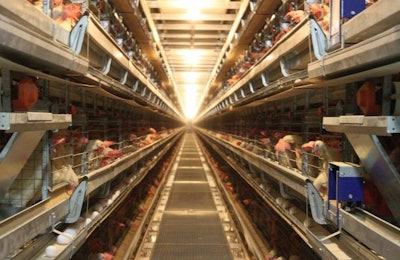
A transition from conventional housing systems in Canadian egg production toward other housing methods has begun, Egg Farmers of Canada (EFC) announced.
EFC, announced the development in a press release issued on February 5 on behalf of more than 1,000 Canadian egg farms.
This approach, described as a "coordinated, systematic, market-oriented transition" will take hen welfare, human health, other resource implications, environmental impact and food production sustainability all into account.
"In response to the best available scientific research and in light of changing consumer preferences, I'm pleased that the entire industry has agreed to an orderly transition plan that will further diversify our production practices," said Peter Clarke, chairman of EFC. "We see immense potential to leverage research and innovation to achieve the best possible outcomes across all factors of sustainable food production, which includes everything from environmental impacts to food affordability," he added.
End of conventional hen housing expected by 2036
This major shift will yield an almost 50 percent restructuring in as early as 8 years from now and includes a commitment to cease the installation of any new conventional hen housing, said EFC.
Presently about 90 percent of egg production is in conventional housing. The other 10 percent is in enriched housing, free-run, aviary or free-range.
Under the plan, to be overseen by a national working group in collaboration with the entire egg supply chain, the industry expects to achieve about a 50-50 percent mix in 8 years, about 85 percent (alternative production) in 15 years. All production would be in enriched housing, free-run, aviary or free-range by 2036 assuming the current market conditions prevail.
Because the market, affordability for consumers, pullet rearing and other supply chain aspects, resource implications, and a number of construction and equipment realities all must be factored in, these projections represent a realistic forecast of what is achievable, EFC stated. The steady, coordinated and cross-supply chain approach will be executed with respect for ensuring supply -- both that there are no supply shortages and that there is no production of eggs for which there is no market -- while pursuing production diversification.
Dialogue about alternative housing systems to take place
Alongside this announcement, EFC said the industry hopes to discuss with stakeholders and consumers the benefits of enriched housing, which do not seem to be well or widely understood outside of the industry. These include food safety, the minimization of mortality, cannibalism, and other aggressive behaviors, ensuring adequate feed and water for all, human health and the lowest possible environmental impacts.
"Egg Farmers of Canada is proud to represent egg farmers across all systems and to offer consumers choice when it comes to eggs," said Clarke. "We are about to take our already high performing industry and best practices in production to even higher levels."
Collaboration with the Coalition for a Sustainable Egg Supply
The welfare, health, production, resource and other tradeoffs between each production method was further assessed by the Coalition for a Sustainable Egg Supply's four-year, commercial-scale study that looked at the sustainability of three different types of hen housing (conventional, aviary and enriched). The study, widely supported by a range of stakeholders, illustrates the complexity involved in evaluating different production methods. For example, it showed that while one production type might have an even higher impact on hen welfare, it also has impacts in terms of human health, the environment, and the economy of the sector that must be considered.
"Egg Farmers of Canada is committed to research, both around production practices and consumer preferences, and to ensuring evidence-based decision-making when it comes to industry practices," Clarke said.
The Canadian egg industry's investments in production method research have shown that enriched housing is a production means that provides the benefits afforded by conventional production and additional features, EFC stated. Enriched housing allows hens to exhibit specific behaviors which may include perching, scratching, foraging, dust bathing and nesting.

















